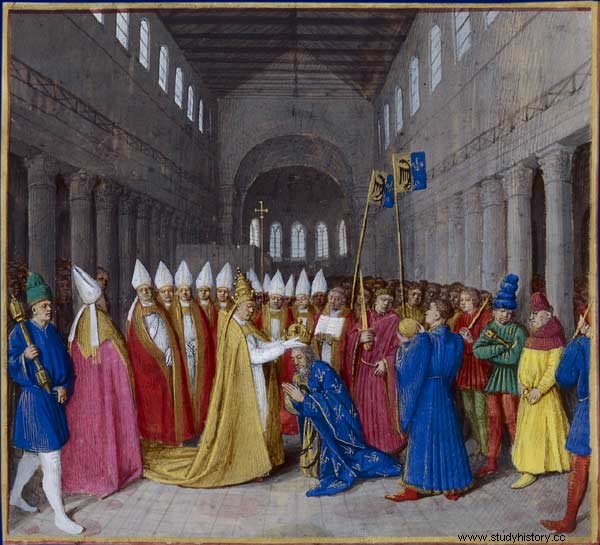On the death of Pepin the Short, the kingdom of France was divided between his two sons, Charlemagne and Carloman. On the death of the latter, Charlemagne becomes the only king of the Franks and reunifies the kingdom, depriving his nephews, the heirs of Carloman. Grandsons of King Didier of Lombardy (Italian region), they found refuge with the king. The latter annexed the territory of the Papacy (Vatican City in Rome) in 772. Also, Charlemagne decided to invade Lombardy. After the long siege of Pavia (Lombardy) in 774, Didier capitulated and was taken prisoner. Charlemagne frees Pope Adrian I st , restrained by force. He becomes king of the Franks and the Lombards, and the great protector of the Church.
December 25, 800

Characters
Charlemagne
Leo III
Procedure
From then on, Charlemagne never stopped expanding his territory. Conquering the Lombards, he then submitted the Saxons and dominated the western part. He is the most powerful king of the time. The ceremony of his coronation to become emperor takes place in the basilica of Rome, on December 25, 800, under the authority of Pope Leo III. In gratitude for the protection of the Franks, the pope awarded Charlemagne the exceptional title of "Emperor of the Romans". Carlus Magnus (Charles the Great) has never lived up to his name so well. The ceremonial of the coronation is that he must wait for the cheers of the crowd calling for him to take power, then take the crown to crown himself. But while he is in prayer, Pope Leo III surreptitiously takes the opportunity to lay the crown himself, signifying that the power comes from God. Charlemagne leaves furious because he wanted to crown himself emperor and owe his power to no one else.
And if the chosen one moved until then from castle to castle, he ended up taking up residence in Aix , in present-day Germany. Work on his palace began around 795 and lasted around ten years, but he settled there in the year 800. hot thermal water! He had a chapel built, with a superb dome; the city will bear the name of Aix-la-Chapelle.
The palace is inspired by the ancient model with columns, arches, vaults... The finest materials such as marble are used and everything is done to evoke Rome, the eternal city. The vast reception room of the palace measures 46 x 20 meters, which is to say the splendor of the court. The sovereign brought together all the intellectuals and artists of the time, as the sovereigns of the Renaissance would later do to promote culture. The library is very rich, scribes and copyists work in the workshop, teaching plays a major role, there are also offices to train civil servants, etc.
Consequences
Charlemagne, to lead his empire, delegated his power to officials. In addition, missi domici report to him on what is happening in his vast territory. He develops jurisprudence by writing numerous capitularies (royal law text divided into chapters, from the Latin capitula ) political, legal, economic or administrative to reform and stabilize his empire.
